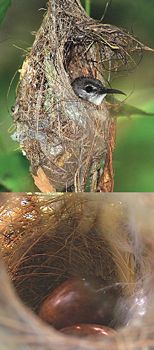“On 26th June 2007, walking along the bund among the mangrove vegetation, I came across two sunbirds flitting among the bushes excitedly. On further observations it was noticed that they were Copper-throated Sunbirds (Leptocoma calcostetha), a male (left top) and a female (left bottom). The female would be perched on a branch while the male would approach her with wings fluttering furiously. Then he would perch right besides her before flying off again.
“However, on this day, I did not realise that there was a nest around the place and walked off looking for subjects to take pictures of.
“The next day I decided to go back to the same place to make further observations. I found the two birds still behaving in a similar fashion. This time I found the nest hanging from a vine and very well camouflaged. Looking into the nest I saw that it was empty, no eggs. I stood around quietly and saw that the female would look into the nest and fly off, then returned and went into the nest – I guess to try it for size. The male would hang around close by observing her every movements.
“On 2nd July I found the female bird inside the nest (right top). She stayed there for a long time before leaving to feed. I peeped into the nest and saw that there were still no eggs. During this period I found the male absent. Only the female was attending to the nest. Can it be because they are nectar feeders, they would find it very hard to feed each other? I may be wrong on this.
“Two days later (4th July) I returned and when the female left the nest, saw two purplish brown eggs (right bottom).
“The 6th July was a very sad day as I found the nest to be missing of the eggs. They could have been predated by a snake as the nest had remained in very good condition. Also, as it was hanging from a vine, anything large and heavy would have torn the nest from the vine. According to a knowledgeable birder, he says that nesting success rate is only about 30 percent. I found incidences like this also happening to Yellow-Vented Bulbul (Pycnonotus goiavier) nests in our garden – overnight, the eggs would disappear into thin air.
“The nest is pear shaped, with an awning over the entrance to protect the female from falling rain? How is it that the male sunbirds would be able to think of this feature?”
K C Tsang, 26th June to 20th July 2007
NOTE: According to Cheke et al. (2001), the nest is a pear-shaped bag with an oval entrance in the top half with an eave. It is made of fine grass, fibre, kapok and hairs, all loosely woven together. There is no ‘beard’ hanging loosely below the nest as in Olive-backed Sunbird (Cinnyris jugularis) (1, 2).
Reference:
Cheke, R. A., Mann, C. F. & Allen, R. (2001). Sunbirds: A guide to the sunbirds, flowerpeckers, spiderhunters and sugarbirds of the world. New Haven & London: Yale University Press.










